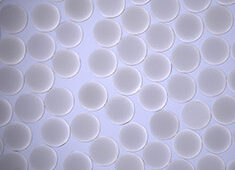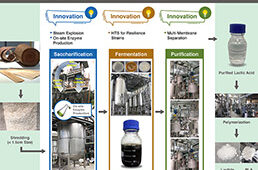A new single-photon emitter is |
Tiny
components with the ability to emit single particles of light are
important for various technological innovations. Physicists of the
Universities of Würzburg, Stuttgart and Ulm have made significant
progress in the fabrication of such structures.
Why are researchers interested in light sources that are able to emit single particles of light?
“Such
light sources are a basic requirement for the development of new
encryption technologies,” explains Professor Jens Pflaum at the
Institute of Physics of the University of Würzburg.
Suitably
equipped components would be able to ensure that data can no longer be
“fished for” during transmission without such process being noticed.
These components might be used, for instance, to increase the security
of online payment systems—since any data manipulation would be
immediately detected and the relevant counter measures could be directly
implemented. This cannot be achieved with conventional light sources,
such as lasers, because these always emit large quantities of identical
light particles or photons as they are referred to by physicists.
Advantages of the innovative light source
An
innovative component that emits single photons has now been introduced
by Professor Pflaum and his cooperation partners from Stuttgart and Ulm
in the prestigious journal Nature Communications.
The
innovative light source has more than just one advantage: It consists
of standard materials for organic light-emitting diodes, is pretty easy
to manufacture and can be electrically controlled. What’s most
important: It works at room temperature. So far, any comparable optical
components manufactured from semiconductor materials, such as gallium
arsenide, are only functional at temperatures far below the freezing
point.
Single color molecules in a matrix
What’s the design of the new component?
“It’s
quite similar to the pixel of a display, familiar to everybody with a
mobile phone,” explains Professor Pflaum: An electrically conductive
layer is applied to a substrate—in our case represented by a glass
plate. Next, an organic plastic matrix, in which the individual color
molecules are embedded, is added onto this layer. The matrix is then
fitted with electrical contacts. If these are connected to a battery, a
flow of electrical current to the color molecules is induced,
stimulating them to continually fire single photons. This has been
demonstrated by the physicists with photon correlation measurements.
Three crucial tricks used
Three
tricks were crucial for the achievement. Number one: “We selected the
right color molecules,” says Maximilian Nothaft of the University of
Stuttgart. The molecules have chemical structures in which three organic
complexes are grouped around one central iridium atom.
The innovative component with which single photons can be produced at room temperature (red arrow) is schematically represented in the diagram below and shown in action in the picture on top. Electric current passes through the circular contacts, stimulating the underlying color molecules to light up. The optically active area of the component is about two millimeters in diameter. Photo: Benedikt Stender |
Trick
number two: The physicists provided for a proper distribution of the
color molecules within the matrix. Too densely packed molecules would
have interacted, no longer emitting single independent photons.
Trick
number three: “The interface between the electrical contacts and the
matrix has been well designed by us,” explains Professor Jörg Wrachtrup
of the University of Stuttgart. This is important for enabling the
required electrons, the carriers of the electric charge, to be injected
into the polymer matrix in the first place. In this case, the scientists
were successful with a contact comprised of an aluminum / barium double
layer.
Glimpse into the future
What
are the physicists going to do next? “We shall try to deposit the
matrix with the color molecules and the electrical contacts onto various
materials so that we can use flexible substrates, such as plastic
films,” says Professor Pflaum. This can be done with a device that works
like an ink jet printer, which is a standard technology that has been
used in laboratories for years. The advantage of this is: The light
sources can be even better positioned on a surface.
Studies funded by DFG
This
success has been achieved under the umbrella of Research Group 730
(“Positioning of single nanostructures – Single quantum devices”), which
is funded by the German Research Foundation (DFG). The spokesperson of
the group is Professor Peter Michler of the University of Stuttgart.
Electrically driven photon antibunching from a single molecule at room temperature






